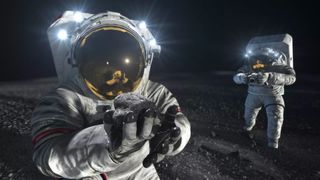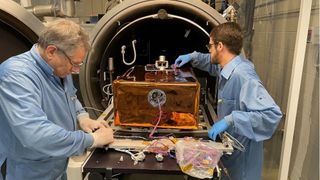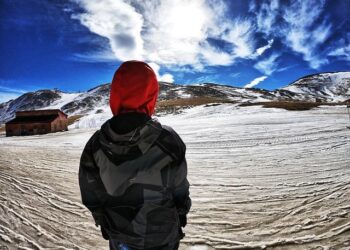
Artist’s illustration of two Artemis astronauts at work on the lunar surface.
(Image credit: NASA)
The Lunar Environment Monitoring Station (LEMS) is one of the first three potential payloads NASA selected for the Artemis 3 mission, which will land humans on the moon in 2026 for the first time in more than 50 years.
The compact, autonomous seismometer is designed to withstand the long, cold lunar night and operate during the day, continuously monitoring ground motion from moonquakes in the region around the lunar south pole, where Artemis 3 astronauts will land. LEMS is expected to operate on the lunar surface for at least three months and up to two years, demonstrating its capability to measure the moon’s geophysical activity unassisted over long periods of time, according to a statement from NASA.
Related: NASA’s Artemis 3 mission: Landing humans on the moon

Richard Mills (left) and Mitchell Hamann prepare to place the LEMS Engineering Unit into a thermal vacuum chamber. During the test, the LEMS prototype was subjected to the harsh temperature and vacuum conditions that mimic the surface of the Moon to demonstrate the station can sustain itself and operate unassisted for long durations. (Image credit: NASA/Mehdi Benna)
“Moonquakes were first observed after Apollo astronauts placed seismometers on the lunar surface during their missions between 1969 and 1972,” NASA officials said in the statement.
However, the Apollo seismic data was collected on the Earth-facing side of the moon near the lunar equator, so there’s no seismic data available on tremors at the lunar south pole, which is important for establishing a long-term presence in this region on the moon.
The researchers, led by planetary scientist Mehdi Benna of the University of Maryland Baltimore County, began developing a small, self-sustaining station that operates almost like a buoy in the ocean. The team received funding from NASA’s Development and Advancement of Lunar Instrumentation program in 2018 to develop LEMS to flight readiness, according to the statement.
Moonquakes are primarily driven by the gravitational pull between the moon and Earth, along with temperature changes on the lunar surface, which vary from 250 degrees Fahrenheit (121 degrees Celsius) during the day to minus 208 degrees F (minus 133 C) at night. These extreme temperature variations cause the moon to expand when it’s hot and contract when it’s cold, making it tremble like a house creaking in response to fluctuating weather on Earth.
Breaking space news, the latest updates on rocket launches, skywatching events and more!
Therefore, studying moonquakes will not only aid in planning Artemis landings but also help scientists better understand what goes on beneath the lunar surface. This information, in turn, will shed light on how the moon formed, given that seismic waves travel through different material at different speeds.
Join our Space Forums to keep talking space on the latest missions, night sky and more! And if you have a news tip, correction or comment, let us know at: [email protected].
Samantha Mathewson joined Space.com as an intern in the summer of 2016. She received a B.A. in Journalism and Environmental Science at the University of New Haven, in Connecticut. Previously, her work has been published in Nature World News. When not writing or reading about science, Samantha enjoys traveling to new places and taking photos! You can follow her on Twitter @Sam_Ashley13.
>>> Read full article>>>
Copyright for syndicated content belongs to the linked Source : Space.com – https://www.space.com/moonquake-detector-nasa-artemis-3-mission































